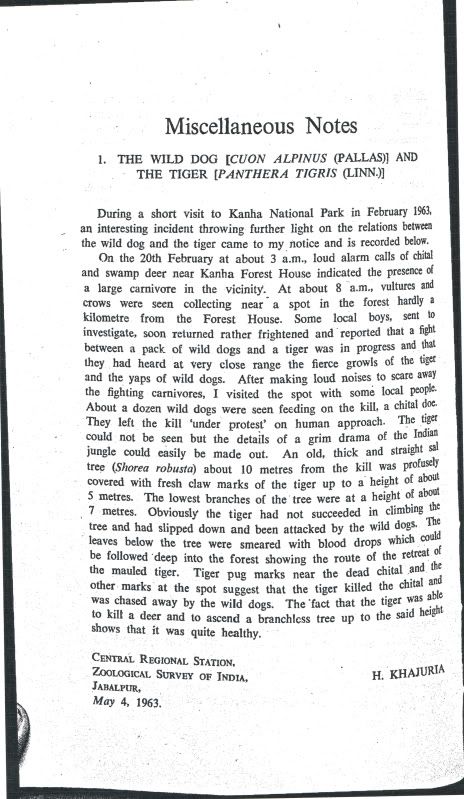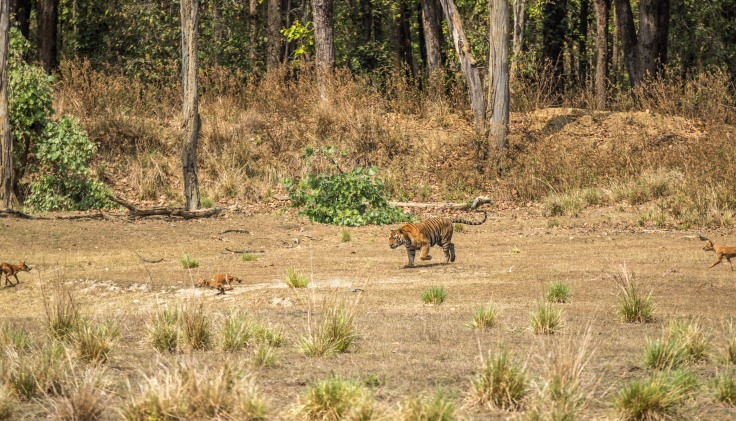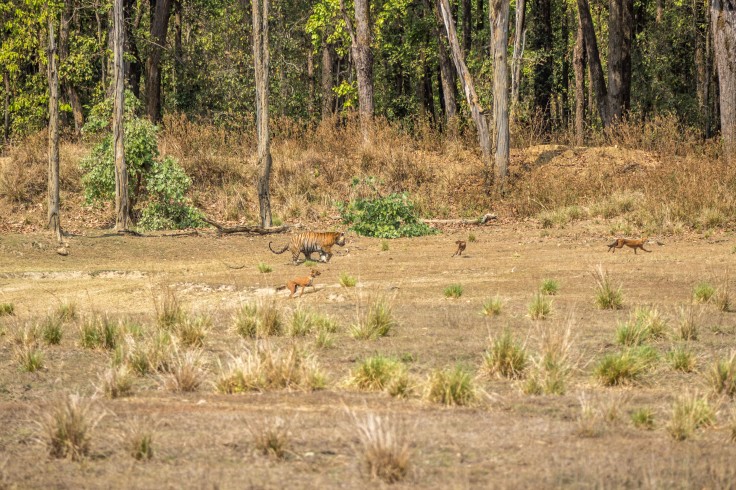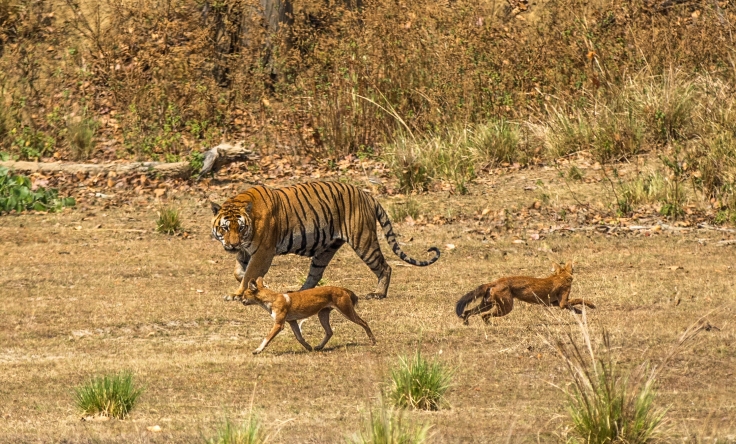Post by dinosauria101 on Feb 21, 2019 21:43:31 GMT 5
Bengal Tiger - Panthera tigris tigris
The Bengal tiger (Panthera tigris tigris) is a tiger subspecies native to the Indian subcontinent that in 2010 has been classified as endangered by IUCN. The total population is estimated at fewer than 2,500 individuals with a decreasing trend, and none of the Tiger Conservation Landscapes within the Bengal tiger's range is large enough to support an effective population size of 250 adult individuals. The Bengal tiger is the most numerous tiger subspecies with populations estimated at 1,520–1,909 in India, 440 in Bangladesh, 124–229 in Nepal and 67–81 in Bhutan. Bengal is traditionally fixed as the typical locality for the binomial Panthera tigris, to which the British taxonomist Reginald Innes Pocock subordinated the Bengal tiger in 1929 under the trinomial Panthera tigris tigris. Bengal Tigers are fully grown at 2-3 years of age. Male reach weights of 200-230 kilograms and up to three metres in length. The females are 130-170 kilograms and up to 2.5 meters long. They have stripes all over their body. Their stripes are like fingerprints. No two are the same. The stripes are not only in the tigers fur, but are a pigmentation of the skin. They have a white spot on the back of their ears, which looks like eyes.
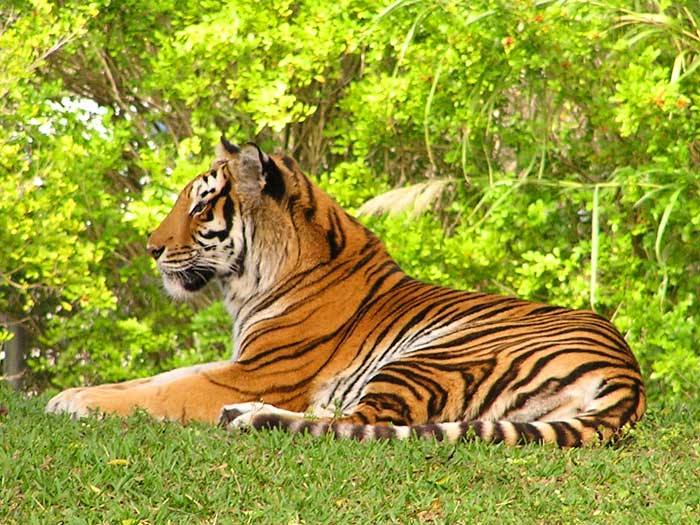
Dhole (pack of 15) - Cuon alpinus
The dhole (Cuon alpinus) is a species of canid native to South and Southeast Asia. It is the only extant member of the genus Cuon, which differs from Canis by the reduced number of molars and greater number of teats. The dholes are classed as endangered by the IUCN, due to ongoing habitat loss, depletion of its prey base, competition from other predators, persecution and possibly diseases from domestic and feral dogs. The dhole is a highly social animal, living in large clans which occasionally split up into small packs to hunt. It primarily preys on medium-sized ungulates, which it hunts by tiring them out in long chases, and kills by disemboweling them. Unlike most social canids (but similar to African wild dogs), dholes let their pups eat first at a kill. Though fearful of humans, dhole packs are bold enough to attack large and dangerous animals such as wild boar, water buffalo, and even tigers. Prey animals in India include chital, sambar, muntjac, mouse deer, swamp deer, wild boar, gaur, water buffalo, banteng, cattle, nilgai, goats, Indian hares, Himalayan field rats and langurs. They are smaller than African wild dogs. Weight ranges from 10 to 25 kg (22 to 55 lb), with males averaging about 4.5 kg (9.9 lb) heavier. This dog is 88 to 113 cm (35 to 44 in) long from the snout to the base of the tail, with the tail averaging 45 cm (18 in) in length. Shoulder height is 42 to 55 cm (17 to 22 in).
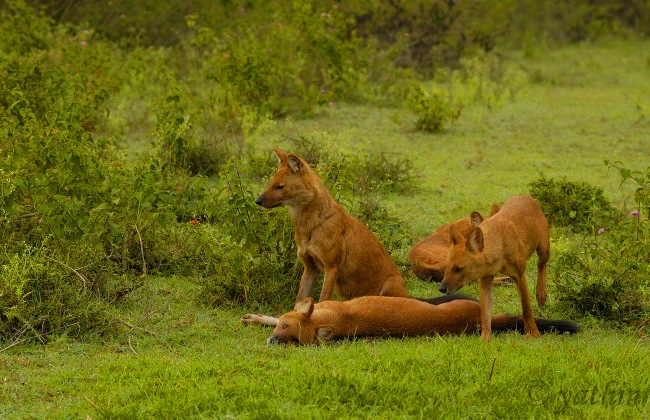
Credit to Wikipedia
The Bengal tiger (Panthera tigris tigris) is a tiger subspecies native to the Indian subcontinent that in 2010 has been classified as endangered by IUCN. The total population is estimated at fewer than 2,500 individuals with a decreasing trend, and none of the Tiger Conservation Landscapes within the Bengal tiger's range is large enough to support an effective population size of 250 adult individuals. The Bengal tiger is the most numerous tiger subspecies with populations estimated at 1,520–1,909 in India, 440 in Bangladesh, 124–229 in Nepal and 67–81 in Bhutan. Bengal is traditionally fixed as the typical locality for the binomial Panthera tigris, to which the British taxonomist Reginald Innes Pocock subordinated the Bengal tiger in 1929 under the trinomial Panthera tigris tigris. Bengal Tigers are fully grown at 2-3 years of age. Male reach weights of 200-230 kilograms and up to three metres in length. The females are 130-170 kilograms and up to 2.5 meters long. They have stripes all over their body. Their stripes are like fingerprints. No two are the same. The stripes are not only in the tigers fur, but are a pigmentation of the skin. They have a white spot on the back of their ears, which looks like eyes.

Dhole (pack of 15) - Cuon alpinus
The dhole (Cuon alpinus) is a species of canid native to South and Southeast Asia. It is the only extant member of the genus Cuon, which differs from Canis by the reduced number of molars and greater number of teats. The dholes are classed as endangered by the IUCN, due to ongoing habitat loss, depletion of its prey base, competition from other predators, persecution and possibly diseases from domestic and feral dogs. The dhole is a highly social animal, living in large clans which occasionally split up into small packs to hunt. It primarily preys on medium-sized ungulates, which it hunts by tiring them out in long chases, and kills by disemboweling them. Unlike most social canids (but similar to African wild dogs), dholes let their pups eat first at a kill. Though fearful of humans, dhole packs are bold enough to attack large and dangerous animals such as wild boar, water buffalo, and even tigers. Prey animals in India include chital, sambar, muntjac, mouse deer, swamp deer, wild boar, gaur, water buffalo, banteng, cattle, nilgai, goats, Indian hares, Himalayan field rats and langurs. They are smaller than African wild dogs. Weight ranges from 10 to 25 kg (22 to 55 lb), with males averaging about 4.5 kg (9.9 lb) heavier. This dog is 88 to 113 cm (35 to 44 in) long from the snout to the base of the tail, with the tail averaging 45 cm (18 in) in length. Shoulder height is 42 to 55 cm (17 to 22 in).

Credit to Wikipedia





